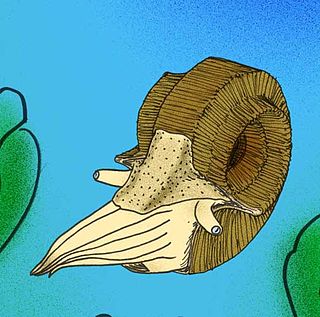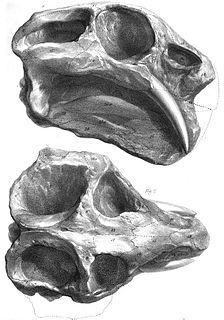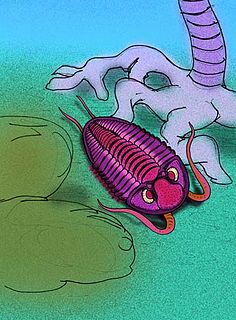 W
WAraxoceras is an extinct genus of ceratitid ammonites that lived in the Late Permian marine environments of Iran, South China and Japan. The various species had distinctive, angular-cornered shells.
 W
WBystrowiana is an extinct genus of bystrowianid chroniosuchian from upper Permian deposits of Vladimir Region, Russia and Jiyuan, China. Chroniosuchians are often thought to be reptiliomorphs, but some recent phylogenetic analyses suggest instead that they are stem-tetrapods. The genus is named in honour of Dr. Alexey Bystrow, who was a Russian paleontologist. It was first named by Vyushkov in 1957 and the type species is Bystrowiana permira. Two species—B. permira and B. sinica—are known.
 W
WClaraia is an extinct genus of scallop-like bivalve molluscs that lived from the Capitanian stage of the Late Permian to the Anisian stage of the Middle Triassic, 266-237 million years ago. Fossils have been found worldwide in North America, Europe, Asia, Africa, and Australia. These are common fossils subsequent to the Permian-Triassic boundary, suggesting that the genus experienced rapid diversification during and after the Permian–Triassic extinction event, around 251.4 million years ago.
 W
WDicynodon is a genus of dicynodont therapsid that flourished during the Upper Permian period. Like all dicynodonts, it was herbivorous. This animal was toothless, except for prominent tusks, hence the name. It probably cropped vegetation with a horny beak, much like a tortoise, while the tusks may have been used for digging up roots and tubers.
 W
WFavosites is an extinct genus of tabulate coral characterized by polygonal closely packed corallites. The walls between corallites are pierced by pores known as mural pores which allowed transfer of nutrients between polyps. Favosites, like many corals, thrived in warm sunlit seas, feeding by filtering microscopic plankton with their stinging tentacles and often forming part of reef complexes. The genus had a worldwide distribution from the Late Ordovician to Late Permian.
 W
WHindeodus is an extinct genus of conodonts in the family Anchignathodontidae. The generic name Hindeodus is a tribute to George Jennings Hinde, a British geologist and paleontologist from the 1800s and early 1900s. The suffix -odus typically describe’s the animal’s teeth, essentially making Hindeodus mean Hinde-teeth.
 W
WJarilinus is an extinct genus of chroniosuchid reptiliomorph from upper Permian deposits of Novgorod and Orenburg Region, Russia. It was first named by V. K. Golubev in 1998, from skull fragments and trunk scutes. The type species is Jarilinus mirabilis.
 W
WMetalegoceras is an extinct genus of marine cephalopods belonging to the family Schistoceratidae.
 W
WTriroetus is a genus of proetid trilobite found in Upper Carboniferous-aged marine strata in Russia, and Lower Permian-aged strata of Thailand, Malaysia, Spitzbergen, Yukon Territory, and Middle Permian-aged marine strata of Oman and Texas.